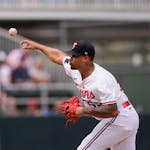 See
more of the story
See
more of the story
Long before he started flashing bunt signs, Paul Molitor was amused by their existence. The Hall of Famer-turned-Twins manager would evolve into one of the most scientific hitters of his generation, and the science he espoused posited that force equals mass times acceleration, as long as you square up a round ball with a rounded sweet spot.
As a kid with the Brewers, Molitor quivered with raw energy at the plate as if the batter's box was electrified. When he reported for his first spring training with the Twins in 1996 at the age of 39, he had become still as a painter's model.
Kirby Puckett took batting practice with his new teammate that February day and nicknamed Molitor's latter-day batting stance "the Molly." And now, as the result of something like osmosis or transference, Byron Buxton is mimicking The Molly, the stance that helped Molitor hit .341 the year he turned 40.
"Well, it's a lot closer than it used to be," Molitor said with a laugh. "I think the whole thing — being a little more spread out and lower and trying to see the ball longer and using his hands — is similar. I think our swing paths are a little different, but I see him now trying to start the bat on his shoulder for a little longer."
Molitor stood still, rested the bat on or near his shoulder, and in a phrase popular among hitting coaches, "let the ball travel," meaning he would try to see it for as long as possible before committing to a swing.
Decades later, Buxton became one of baseball's best prospects by relying on exceptional bat speed. "In the minor leagues, they just tell you to go out and play and try to get up here to the big leagues," Buxton said. "You're kids. You don't understand. I just had to figure some stuff out. I had to change some stuff and find a way to put the ball in play."
Out went the exaggerated leg kick that made Buxton look like a skinny Puckett. In went an inadvertent imitation of "the Molly." Buxton now takes a wide stance, keeps his feet planted and … waits.
Tuesday, during the Twins' showdown with Cleveland, Buxton drove in the first run of the game by lining a fastball to left. He has eight hits in his past 17 at-bats. In his past 20 games, he is batting .369.
Sunday, he hit a game-winning single up the middle on a low-and-outside pitch that Buxton's previous swing would have missed by a foot. "No question," Molitor said.
So much of the modern news cycle concerns itself with nervous roster permutations. Will the Twins trade away a mediocre pitcher, or trade for one? Will the next kid you've never heard of from Triple-A last one or two weeks?
What remains most important for this franchise is the development of young players. With his new approach and newfound confidence, Buxton is back on track to become a five-tool star. That's the story of the summer, not whether Jaime Garcia is wearing pinstripes or Twinstripes.
"You can tell he's a lot more patient, he's taking pitches he used to swing at," Max Kepler said. "He was the best player I ever played with in the minors."
One of the fastest players in baseball is becoming a big-league hitter by slowing himself down. He has hit home runs recently by swinging half as hard as he did on May strikeouts. In baseball, force equals mass times acceleration only if you make contact.
"Hey, this didn't really come from me," Molitor said. "I think he's feeling better. He's not missing as many pitches, he's not chasing as much, and that's a pretty good combination."
Tuesday's 8-1 loss to Cleveland leaves the Twins six games out of the division lead and third in the race for the second wild card, more proof that Buxton's development is more important than a long-shot race for a one-game playoff.
Jim Souhan's podcast can be heard at MalePatternPodcasts.com. On Twitter: @SouhanStrib. • jsouhan@startribune.com





